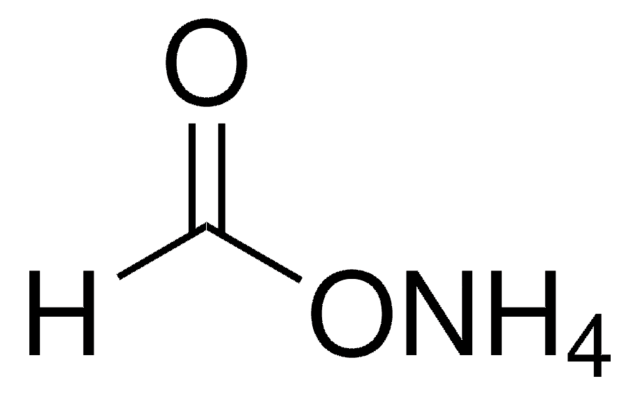Key Documents
69892
MES monohydrate
BioXtra, ≥99.0% (T)
Synonim(y):
2-(4-morpholino)ethanesulfonic acid, 2-morpholinoethanesulfonic acid, Morpholine-4-ethanesulfonic acid hydrate, 2-(N-Morpholino)ethanesulfonic acid, 4-Morpholineethanesulfonic acid monohydrate
About This Item
Polecane produkty
linia produktu
BioXtra
Poziom jakości
Próba
≥99.0% (T)
Postać
powder or crystals
przydatny zakres pH
5.5-6.7
pKa (25°C)
6.1
mp
>300 °C (lit.)
rozpuszczalność
H2O: 0.5 M at 20 °C, clear
gęstość
10.66 g/mL
ślady anionów
chloride (Cl-): ≤50 mg/kg
sulfate (SO42-): ≤50 mg/kg
ślady kationów
Ca: ≤50 mg/kg
Cd: ≤5 mg/kg
Co: ≤5 mg/kg
Cr: ≤5 mg/kg
Cu: ≤5 mg/kg
Fe: ≤5 mg/kg
K: ≤50 mg/kg
Mg: ≤5 mg/kg
Mn: ≤5 mg/kg
Na: ≤50 mg/kg
Ni: ≤5 mg/kg
Pb: ≤5 mg/kg
Zn: ≤5 mg/kg
Zastosowanie
agriculture
diagnostic assay manufacturing
general analytical
microbiology
obecność zanieczyszczeń
DNase, none detected
NICKase, none detected
RNase, none detected
protease, none detected
ciąg SMILES
O.OS(=O)(=O)CCN1CCOCC1
InChI
1S/C6H13NO4S.H2O/c8-12(9,10)6-3-7-1-4-11-5-2-7;/h1-6H2,(H,8,9,10);1H2
Klucz InChI
MIIIXQJBDGSIKL-UHFFFAOYSA-N
Szukasz podobnych produktów? Odwiedź Przewodnik dotyczący porównywania produktów
Opis ogólny
Zastosowanie
- to adjust the pH of the growth medium, facilitating gene expression analyses aimed at understanding the molecular mechanisms
- in the fixation and imaging of cellular components, enabling the study of hypotonic stress′s physiological effects on cell structure and function through Super-Resolution and Live-Cell Microscopy
- to adjust the pH of the growth medium to 5.5-7.0 in an in vitro cell wall stress assay
- as a buffering agent to stabilize enzymatic solutions
- as a component of PAGE running buffer
Cechy i korzyści
- Suitable for Biochemical and Cell Biology Research
- Tested for the presence of anionic and cationic traces
- Tested to confirm low levels of heavy metal contamination, ensuring suitability for various applications
- Effective Buffering from pH 5.5-6.7 (25 °C) with a pKa of 6.1 (25 °C)
Uwaga dotycząca przygotowania
Inne uwagi
Sterilization: Sterilization should be by filteration through 0.2μM filters. Autoclaving is not recommended by any sulfonic acid buffers. If buffers must be nuclease-free, it is best to treat the water, then add the buffer solids after autoclaving. When MES solutions are autoclaved, they turn yellow (although pH does not change measurably. The identity of the yellow breakdown product is unkown.
Kod klasy składowania
11 - Combustible Solids
Klasa zagrożenia wodnego (WGK)
WGK 1
Środki ochrony indywidualnej
dust mask type N95 (US), Eyeshields, Gloves
Certyfikaty analizy (CoA)
Poszukaj Certyfikaty analizy (CoA), wpisując numer partii/serii produktów. Numery serii i partii można znaleźć na etykiecie produktu po słowach „seria” lub „partia”.
Masz już ten produkt?
Dokumenty związane z niedawno zakupionymi produktami zostały zamieszczone w Bibliotece dokumentów.
Klienci oglądali również te produkty
Nasz zespół naukowców ma doświadczenie we wszystkich obszarach badań, w tym w naukach przyrodniczych, materiałoznawstwie, syntezie chemicznej, chromatografii, analityce i wielu innych dziedzinach.
Skontaktuj się z zespołem ds. pomocy technicznej




